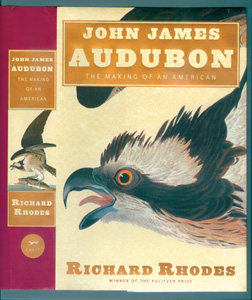![[Metroactive Features]](http://metroactive.com/features/gifs/feat468.gif)
[ Features Index | Silicon Valley | Metroactive Home | Archives ]
2004 Gift Guide
My Big Fat Art Books Gift Guide
By Michael S. Gant
I DON'T have my diploma in gift-giving hung on the wall, but my expert advice for 2004 is: Don't give anybody any books about politics of any kind. Enough already. Instead, the holidays are a good time to indulge in big fat art books. Not only will they provide hours of ongoing reading and viewing pleasure (unlike the gag gift that gets a guffaw and then languishes until the next garage sale), but artfully arranged on a coffee table, they function as art objects. So, in no special order, except vaguely anti-chronological in order to escape thinking about the present, consider:
Primal Images (Center for American Places, University of Chicago Press; $50 cloth) Trolling the banks of the Amazon, Jerry Burchfield creates "lumen prints" of plants. Using a technique borrowed from the earliest days of photography, he presses his specimens against black-and-white photographic paper and then exposes them to the sun and elements. The results are ghostlike and surprisingly colorful (due to vagaries in the chemicals). Some plants—fern fronds—retain their familiar shape in shadowy outline; other flowers and leaves dissolve into abstract forms hovering in fields of muted pastels.
Consensus in the arts is hard to come by, but everyone agrees on who the greatest American architect was. Frank Lloyd Wright: The Interactive Portfolio by Margo Stipe (Running Press; $40 cloth) reiterates the obvious in novel fashion. The slipcased volume features a variety of surprises in the form of fold-out pages and pasted-in envelopes containing reproductions of Wright's original plans, typescript letters and prospectuses for his famous buildings, from Fallingwater to the Guggenheim Museum. Most intriguing are the materials relating to the Midway Gardens, a failed entertainment complex in Chicago that shows Wright in a rare whimsical mood. The project, alas, succumbed to Prohibition and was torn down in 1929.
Two thick biographies look at the creation and marketing of art. Duveen by Meryle Secrest (Knopf; $35 cloth) traces the life and machinations of Joseph Duveen, the famous British art dealer who made a fortune buying old master paintings from cash-poor European aristocrats and selling them to American robber barons (who eventually willed them to our best-endowed museums). Along the way, Duveen engaged in some shady jobbing of the art market, especially his incestuous relationship with art expert Bernard Berenson, who took a healthy cut from the sale of Renaissance paintings whose authenticity he himself guaranteed.
More edifying is John James Audubon: The Making of an American by Richard Rhodes (Knopf; $30 cloth). The self-taught naturalist and painter of the early 1800s toiled at great cost to his health and his marriage (Rhodes quotes many tense letters that passed between Audubon and his wife, Lucy, during their frequent months and years apart) to create the unsurpassed Birds of America, a set of extraordinary hand-colored engravings on extra-large sheets of paper known as elephant portfolios. Just as difficult as his expeditions in the still wild American forest seeking specimens were Audubon's forays to England and Europe, where he wrestled with finding a printer capable of realizing his project and subscribers capable of paying for it.
Not many paintings deserve an entire book all to themselves. Seurat and the Making of La Grande Jatte by Robert L. Herbert (The Art Institute of Chicago and the University of California Press; $34.95 paper) makes the case for French painter Georges Seurat's famous pointillist (although Herbert shows that the common term for Seurat's style is a misnomer) masterpiece depicting bourgeois types on a day's outing in the park. With reproductions and microscopic close-ups, the book tracks the influences on Seurat and examines his working method and theories of color mixing. Only for the dedicated art lover, but a magnificent example of art scholarship.
Finally, looking way back, Courtly Art of the Maya (Thames & Hudson; $50 paper) is the companion volume (somehow catalog doesn't seem grand enough) to the current show at the Fine Arts Museums of San Francisco of artifacts from the mysterious race that flourished in lower Mexico and Guatemala until about 900 B.C.E., creating such fabled cities as Palenque, Yaxchilan and Copan. The essays, by various expert contributors, are scholarly but not impenetrable, and the photographs of sculptures, multicolored vases, carved stones and intricate hieroglyphs are ceaselessly fascinating.
[ Silicon Valley | Metroactive Home | Archives ]
Copyright © Metro Publishing Inc. Metroactive is affiliated with the Boulevards Network.
For more information about the San Jose/Silicon Valley area, visit sanjose.com.
![]()

Bird Brain: A new biography charts the remarkable life of avian artist John James Audubon.
![[line]](/gifs/line.gif)
Gifts for the festive film lover
Holiday gifts for the Paris Hilton wannabe
Musical cure-alls for the difficult giftee in your life
Clutterless gifts
My big fat art books guide
Scandalous gifts for the lusty angel in your life
Expert gift recommendations for your
favorite workplace prankster
Holiday happenings
![[line]](/gifs/line.gif)
All Booked Up
Send a letter to the editor about this story to letters@metronews.com.
From the November 17-23, 2004 issue of Metro, Silicon Valley's Weekly Newspaper.